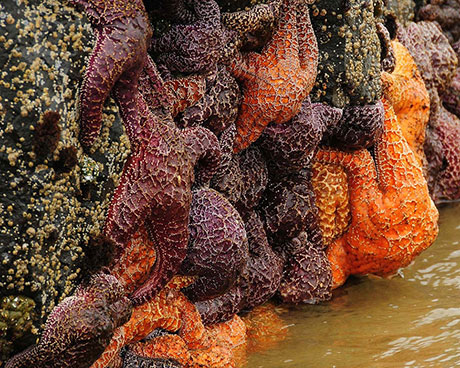The concept of a keystone species, one that affects its biological community assemblage, in both direct and indirect ways which are out of proportion to its biomass, is based on research done on the ochre sea star, Pisaster ochraceus, in the rocky intertidal zone (Paine 1969). Dr. Robert Paine’s concept that a keystone species shapes it biological community continues to influence ecological theory and has been expanded from the rocky intertidal environment to most ecoregions on earth. The predatory ochre sea star selectively feeds on mussels effectively creating space and opportunities for many other species to live and thrive.
The ochre star is familiar to Oregonian tide pool visitors, divers and aquarium goers. The species ranges from Alaska to Baja, California. In June 2013, researchers monitoring tide pools along the Washington coast noticed great numbers of ochre stars dying through a process called sea star wasting syndrome. Sea star wasting syndrome is characterized by a set of symptoms that include appearance of external lesions, followed by tissue decay, fragmentation of the body and death. Sometimes an affected sea star looks deflated before other symptoms are visible. While these symptoms are typical of sea stars stranded high and dry out of their normal habitat, what is unusual in sea stars experiencing wasting syndrome is that they are found in normally suitable habitat often with many others of the same species that are also affected. Sea stars may die within a few days of the first symptoms appearing.
Outbreaks of sea star wasting syndrome occurred previously in the 1970s, 1980s and the 1990s. What is different this time is that the geographic area over which it is occurring and the numbers of sea stars affected appear to be unprecedented. After first being documented on the Washington coast, outbreaks in Canada’s British Columbia, California, Washington’s Puget Sound and Alaska were found. Not long afterward outbreaks in Oregon and Mexico were discovered. At the rocky intertidal sites along the Oregon coast monitored by Oregon State University researchers for many years, ochre sea star populations declined by 85 to 90 % in a matter of months. Sea star wasting syndrome is affecting a variety of other sea star species on the Pacific Coast including: mottled stars (Evasterias troschelii), leather stars (Dermasterias imbricate), six-armed stars (Leptasterias), sunflower stars (Pycnapodia helianthoides), rainbow stars (Orthasterias koehleri), giant pink stars (Pisaster brevispinus), giant stars (Pisaster giganteus), sun stars (Solaster), vermillian stars (Mediaster aequalis), and bat stars (Patria miniata).
The cause or causes of sea star wasting syndrome, the reasons for the outbreak, and the ecological consequences are not fully understood. Research is underway at universities around the nation. A number of factors that may be involved such as warmer than normal water temperatures, salinity, pH, water pollution, and the role of pathogens like the bacteria, viruses and protezoa are being investigated as well as combinations of these factors. One pathogen, a densovirus, has been identified as a likely agent of infection, but evidence that this pathogen has been present along the Pacific coast for over 70 years suggests that other factors are involved in this widespread outbreak of sea star wasting syndrome (Hewson et al. 2014). There is evidence that warmer water temperatures may be a factor that increased disease rates and mortality in ochre stars in some areas (Eisenlord et al. 2016), but in Oregon that did not appear to be the case (Menge et al. 2016).
The ecological effects of population declines of the keystone predator, the ochre star, are also under investigation. Long term studies of intertidal species and habitat along the Oregon coast allowed Menge et al. (2016) to document the dramatic declines in both density and biomass of adult ochre stars caused by sea star wasting syndrome, measure the immediate decline in their predation rates on mussels from its long term average, observe an unprecedented increase in recruitment of young ochre stars and provide ecological perspective on these events. Continued research and monitoring will be the key to understanding why these outbreaks occurred, what the ecological consequences will be, and if sea star populations will recover.

